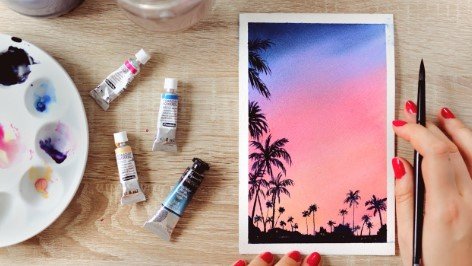5 Essential Tips To Keep In Mind When Painting With Watercolours

Painting is an artistic endeavour that showcases creativity and skill. It is one of the most rewarding artistic forms, as it offers the flexibility to express oneself whichever way one wants. However, painting with watercolours can be tricky since many factors must be considered when using these materials. This article showcases five tips painters should consider when painting with watercolours.
Selection Of Paint
When pursuing this artistic expression, choosing suitable watercolor paints is crucial. They come in various variants, each with a different purpose. There are three types: tubes, cakes, and liquid. Tubes are best suited for people who try to incorporate bold hues, which is quite necessary for creating lucid backgrounds over which people can establish their vision. Cakes are best suited for people who like to travel and draw. They are small and are equally efficient in helping reproduce artistic expressionism. Liquids are for those who delve into the wet-on-wet art form. They are pretty competent in creating and blending light and beautiful washes.
Try To Nail The Water-To-Colour Ratio
While watercolour painting may seem relatively straightforward, specific fine points need to be mastered, such as the transparency of the hue. This is imperative for anyone trying to create an artwork with varying layers of hues and gradients. One of the things they can do is master the ratio of water and colour. A mixture of less colour and more water is beneficial if one needs a light wash. However, if the art demands strong colour usage to create the base of the work or the background, more paint and less water can seem quite beneficial. People may find this ratio hard to nail initially, but this becomes relatively easy with persistent practice and proper research.
Explore Varied Techniques
The best thing about this artistic form is its wide variety of choices for painters. For people who want to create unique and eye-catching art pieces, mastering varied art techniques can help in this endeavour. There are many different styles, from the popular wet-on-wet technique, which incorporates the use of hues on an already applied layer of colour, to the unique and stylistic dry brush technique, which defines using a brush without wetting it in paint; there are a lot of different styles that one can master. With some knowledge about these styles and which style would best go with one’s desired work, artists can create beautiful pieces that transcend the threshold of the ordinary.
Read also: Repairing Water-Damaged Ceilings in Toronto: Expert Solutions
It’s All In The Brush Strokes
When working with watercolour, the way people use their brushes can determine the outcome of the painting. Learning which art type requires what sort of brushstroke can help people bring what they envision to life. Light brush strokes can help them achieve lighter gradients, whereas deep brush strokes can help them render punchy hues to the work. Also, the angle at which the brush is being held can strongly impact the work’s outcome. All in all, brush strokes may seem easy, just adding colours and splashing them across the canvas, but nailing down how to use them and which way suits the work best can help people a lot.
The Need For Practice
Art is something that cannot be done right in just one try. And it should not act as a choker on artistic expressionism. Practice can help people side-step this quite easily. With every piece being drawn, painters can assess where they fall short, what they can work on for much better results and what things are working in their favour. Plus, with practice, intuition factors take the backseat, and people become more knowledgeable about how to best express their ideas on the canvas.
Watercolour painting is one of the most expressive and beautiful ways of emancipating artistic expressionism. With these five tips, it becomes much more manageable. From selecting suitable watercolor paints to learning more about brush strokes, these tips can help people bring out the best in their works. With persistent practice and practical steps, the form will become an enjoyable expressionist liaison.





